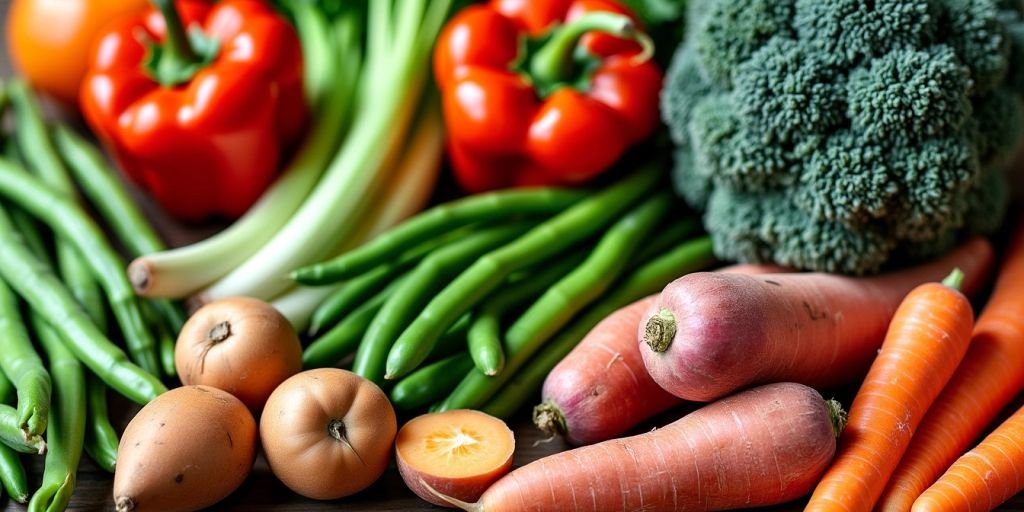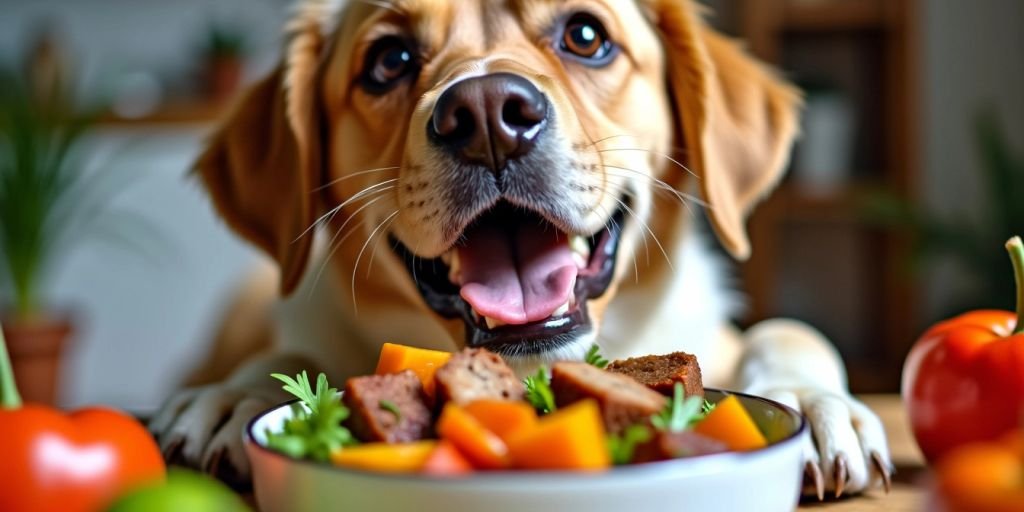
Feeding your dog vegetables can be a great way to give them extra nutrients and keep them healthy. Many veggies are safe for dogs to eat and can be served in different ways, like raw, steamed, or pureed. However, it’s important to know which vegetables are safe and how to prepare them properly to avoid any health issues.
Key Takeaways
- Carrots are a great source of vitamins and can be served raw or cooked.
- Green beans are low in calories and high in fiber, making them a great snack for dogs.
- Broccoli is packed with vitamins but should be given in moderation to avoid stomach issues.
- Sweet potatoes are rich in vitamins and minerals that support your dog’s overall health.
- Bell peppers are full of nutrients and can be a crunchy treat for your dog.
1. Carrots
Carrots are a fantastic choice for a healthy dog treat. They are high in fiber and low in calories, making them a great snack option. Carrots contain beta-carotene, which produces vitamin A, essential for your dog’s vision and immune system.
Nutritional Benefits
- Vitamin A: Supports vision and immune health.
- Fiber: Aids in digestion and helps maintain a healthy weight.
- Low in calories: Great for weight management.
Serving Tips
- Raw Carrots: These can be given as crunchy treats. They also help clean your dog’s teeth and can be frozen to relieve teething pain in puppies.
- Cooked Carrots: Steamed or boiled carrots are easier to digest and can be mixed into your dog’s regular food.
- Pureed Carrots: Blending carrots into a puree can make it easier for your dog to absorb the nutrients.
Carrots are not only nutritious but also fun for dogs to crunch on. Just remember to serve them in moderation due to their natural sugar content.
2. Green Beans
Green beans are a fantastic, low-calorie treat for dogs. They can be served chopped, steamed, raw, or even canned, as long as they are plain and unsalted. Green beans are packed with essential vitamins and minerals, including vitamins A, B6, C, and K, as well as protein, iron, calcium, and fiber.

Nutritional Benefits
Green beans are not only low in calories but also high in fiber, which helps dogs feel full without overeating. They are a great source of:
- Vitamin A: Supports vision and immune function.
- Vitamin B6: Important for brain health and energy metabolism.
- Vitamin C: Boosts the immune system and acts as an antioxidant.
- Vitamin K: Essential for blood clotting and bone health.
- Iron: Crucial for oxygen transport in the blood.
- Calcium: Supports bone health.
- Fiber: Aids in digestion and helps maintain a healthy weight.
Serving Tips
When serving green beans to your dog, consider the following tips:
- Choose Plain Green Beans: Avoid any added salt, spices, or oils.
- Serve in Moderation: While green beans are healthy, they should be part of a balanced diet.
- Mix with Regular Food: Add chopped or pureed green beans to your dog’s regular meals for an extra nutritional boost.
- Frozen Green Beans: These can be a fun and crunchy treat, especially on hot days.
Green beans are a versatile and nutritious addition to your dog’s diet, offering a range of health benefits without adding extra calories.
3. Broccoli
Broccoli is a powerhouse of nutrients that can be beneficial for your dog. It contains a variety of vitamins, including vitamin K, vitamin C, and potassium, which can help improve bone density, fight diseases, and support heart health. However, it’s important to feed broccoli in moderation as it contains isothiocyanates, which can cause stomach upset in some dogs.
Nutritional Benefits
- Vitamins: K, C, and A
- Minerals: Potassium, calcium, and magnesium
- Fiber: Aids in digestion
- Antioxidants: Helps in fighting diseases
Serving Tips
- Raw or Cooked: Both are safe, but cooked broccoli is easier to digest.
- Small Portions: Start with small amounts to see how your dog reacts.
- Avoid Seasoning: Plain broccoli is best; avoid adding salt or spices.
- Mix with Other Foods: Combine with your dog’s regular food for added nutrients.
Broccoli can be a great addition to your dog’s diet, but always remember to introduce it slowly and watch for any adverse reactions.
4. Sweet Potatoes
Sweet potatoes are a fantastic addition to your dog’s diet. They are rich in vitamin A, which helps keep your dog’s skin and fur healthy. This vitamin also supports the nervous system and muscles. Sweet potatoes are also packed with potassium and calcium, which are essential for your dog’s overall health.
Nutritional Benefits
- Vitamin A: Promotes healthy skin, fur, and supports the nervous system and muscles.
- Vitamin C: Boosts the immune system.
- Vitamin B6: Important for brain and body functions.
- Potassium and Calcium: Essential for muscle and bone health.
- Fiber: Aids in digestion and helps maintain a healthy weight.

Serving Tips
- Cooked and Mashed: Boil or bake the sweet potatoes, then mash them up. Make sure they are plain, without any added sugar or spices.
- Mixed with Regular Food: Add small pieces of cooked sweet potatoes to your dog’s regular food for an extra nutritional boost.
- Sweet Potato Treats: You can find or make sweet potato dog treats. Just ensure they are free from harmful additives.
Sweet potatoes are low in fat and can be a great, healthy treat for your dog. Just remember to serve them in moderation to avoid any digestive issues.
5. Bell Peppers
Bell peppers are a fantastic addition to your dog’s diet. They are made up of 92% water and are packed with essential nutrients, including vitamins A, E, B6, potassium, and folate. These colorful veggies are not only nutritious but also make for a fun, crunchy snack that most dogs love.
Nutritional Benefits
- Vitamins: Bell peppers are rich in vitamins A, B6, and E, which are crucial for maintaining your dog’s overall health.
- Antioxidants: They contain antioxidants like vitamin C and beta-carotene, which help promote a healthy immune system.
- Hydration: With their high water content, bell peppers can help keep your dog hydrated.
Serving Tips
- Remove Seeds and Stems: Always remove the seeds and stems before serving bell peppers to your dog, as these parts can be tough to digest.
- Introduce Slowly: Start by giving small amounts to see how your dog reacts. Gradually increase the quantity if there are no adverse reactions.
- Raw or Cooked: Bell peppers can be served raw, steamed, or cooked. Avoid adding any seasoning or spices.
Bell peppers are a safe and healthy treat for your dog, but moderation is key. Too many vegetables can upset your dog’s stomach.
Incorporating bell peppers into your dog’s diet can offer numerous health benefits while adding a bit of variety to their meals.
6. Spinach
Spinach is a nutrient-rich leafy green that can be a healthy addition to your dog’s diet. It contains essential vitamins and minerals such as potassium, magnesium, and vitamins B6, B9, and E. Additionally, spinach is high in carotenoids, vitamin C, vitamin K, folic acid, iron, and calcium.
Nutritional Benefits
- Iron: Supports the production of red blood cells.
- Fiber: Aids in digestion and helps maintain a healthy weight.
- Vitamins A, C, and K: Boosts the immune system and promotes healthy skin and coat.
- Antioxidants: Protects cells from damage and supports overall health.
Serving Tips
- Moderation is Key: Spinach contains oxalic acid, which can block calcium absorption and potentially lead to kidney damage if consumed in large amounts. Therefore, it’s best to serve spinach in moderation.
- Preparation: Wash the spinach thoroughly to remove any pesticides or chemicals. You can serve it raw, steamed, or lightly cooked. Avoid adding any seasoning or oils.
- Mix with Other Foods: To make it more appealing, mix chopped spinach into your dog’s regular food or combine it with other dog-friendly vegetables.
While spinach offers numerous health benefits, always consult your veterinarian before introducing new foods into your dog’s diet to ensure it’s safe for your specific pet.
7. Celery
Celery is a fantastic, crunchy snack for dogs that offers numerous health benefits. It’s high in water content, making it a great option for hydration. Celery is also low in calories and fat, which makes it ideal for dogs that need to lose a few pounds.
Nutritional Benefits
Celery is packed with essential vitamins and minerals, including:
- Vitamins A, B, C, and K
- Folate
- Potassium
- Manganese
These nutrients help support your dog’s overall health, from boosting their immune system to promoting healthy skin and coat.
Serving Tips
Before giving celery to your dog, make sure to de-string it to avoid any choking hazards. Here are some ways to serve celery to your dog:
- Raw: Cut into small, bite-sized pieces.
- Cooked: Lightly steamed without any added salt or seasoning.
- Mixed: Combine with other dog-safe vegetables for a nutritious treat.
Celery can also help freshen your dog’s breath, making it a dual-purpose treat that’s both healthy and refreshing.
Always introduce new foods gradually and consult your vet if you have any concerns.
8. Peas
Peas are a fantastic addition to your dog’s diet. They are packed with protein, fiber, and essential vitamins like A, C, and K. Fresh or frozen peas can be a delightful treat or a nutritious supplement to your dog’s regular meals.
Nutritional Benefits
- Protein: Helps in muscle development and repair.
- Fiber: Aids in digestion and maintains a healthy gut.
- Vitamins A, C, and K: Support vision, immune function, and blood health.
Serving Tips
- Fresh or Frozen: Always opt for fresh or frozen peas. Avoid canned peas as they often contain added sodium, which is not good for dogs.
- Mix with Meals: You can mix peas into your dog’s regular food to add a nutritional boost.
- As a Snack: Serve peas as a standalone snack for a quick, healthy treat.
Peas are not just tasty but also a powerhouse of nutrients that can contribute to your dog’s overall well-being. Just remember to serve them in moderation to avoid any digestive issues.
9. Beets
Beets are a nutrient-rich vegetable that can be a great addition to your dog’s diet. They are packed with essential vitamins and minerals, including vitamin C, fiber, folate, manganese, and potassium. These nutrients can help improve your dog’s digestion, boost their immune system, and support healthy skin and coat.
Nutritional Benefits
- Vitamin C: Helps boost the immune system and promotes healthy skin.
- Fiber: Aids in digestion and helps maintain a healthy weight.
- Folate: Supports cell growth and function.
- Manganese: Important for bone health and metabolism.
- Potassium: Helps maintain proper muscle and nerve function.
Serving Tips
- Cooked Beets: Always cook beets before serving them to your dog. Raw beets can be hard to digest and may cause stomach upset.
- Small Portions: Serve beets in small portions to avoid any potential digestive issues. A few small pieces mixed with their regular food is a good start.
- Avoid Additives: Make sure the beets are plain, without any added salt, butter, or seasonings.
Moderation is key when introducing new foods to your dog’s diet. Always consult with your vet before making any significant changes to ensure it’s safe for your pet.
10. Zucchini
Zucchini is a fantastic vegetable for dogs, offering a range of nutritional benefits. It’s low in calories, fat, and cholesterol, making it a healthy choice for your furry friend. This veggie is packed with fiber, antioxidants, and essential vitamins like A, C, B6, and K.
Nutritional Benefits
- Low in Calories: Helps maintain a healthy weight.
- Rich in Fiber: Aids in digestion and keeps your dog feeling full.
- Antioxidants: Supports overall health and fights off free radicals.
- Vitamins A, C, B6, and K: Essential for various bodily functions, including vision, immune support, and blood clotting.
Serving Tips
- Raw: Cut into small, bite-sized pieces for a crunchy treat.
- Steamed: Softens the texture, making it easier to chew and digest.
- Cooked: Can be mixed into your dog’s regular food for added nutrients.
Moderation is key. Too much zucchini can lead to digestive issues. Always introduce new foods gradually and consult your vet if you have any concerns.
Quick Freezing Tip
Cook zucchini in large batches and store in the freezer. After pureeing, place the veggie mix in an ice cube tray. This way, you can easily grab a cube when you’re in a hurry. Simple and healthy!
Conclusion
In conclusion, feeding your dog vegetables can be a great way to boost their health and add variety to their diet. Many veggies are packed with essential vitamins and minerals that can benefit your dog’s coat, skin, and overall well-being. Remember to always prepare the vegetables properly by washing, chopping, and sometimes cooking them to make them easier to digest. While vegetables can be a healthy addition, they should only make up a small portion of your dog’s diet. Always consult with your vet before introducing new foods to ensure they are safe for your furry friend. By doing so, you can enjoy the peace of mind that comes with knowing you’re providing your dog with nutritious and safe treats.
Frequently Asked Questions
Can dogs eat raw vegetables?
Yes, dogs can eat raw vegetables. However, some veggies are easier to digest when cooked or pureed.
How should I introduce new vegetables to my dog’s diet?
Start by giving small amounts and monitor your dog for any adverse reactions. Gradually increase the amount if your dog tolerates it well.
Are there any vegetables that are harmful to dogs?
Yes, some vegetables like onions, garlic, and wild mushrooms can be toxic to dogs. Always check with your vet before introducing new foods.
How can I prepare vegetables for my dog?
You can serve them raw, steamed, blanched, or pureed. Make sure to chop them into small, manageable pieces to avoid choking.
Can vegetables replace meat in my dog’s diet?
No, vegetables should not replace meat. Dogs are omnivores and need a balanced diet that includes protein from meat.
How much vegetable content is safe in my dog’s diet?
Vegetables should make up less than 25% of your dog’s diet. Too many vegetables can cause digestive issues.




